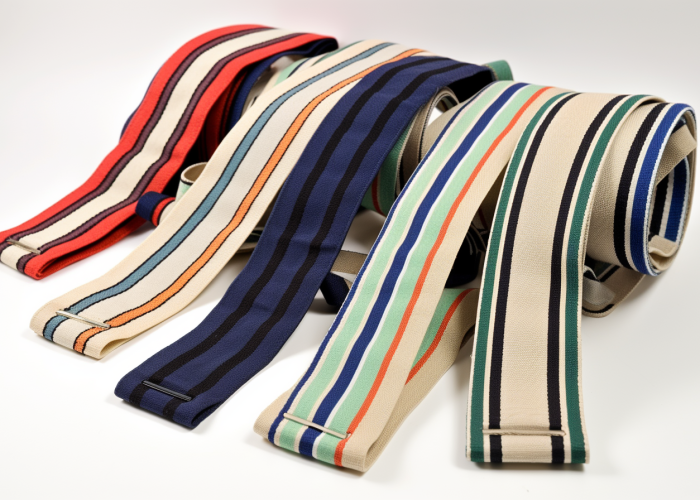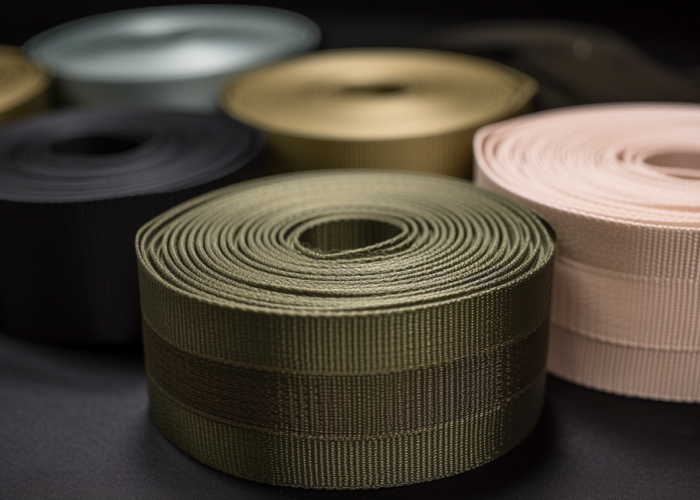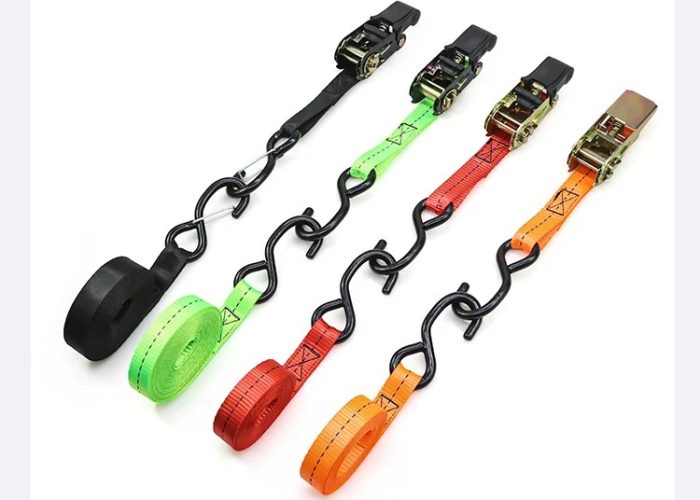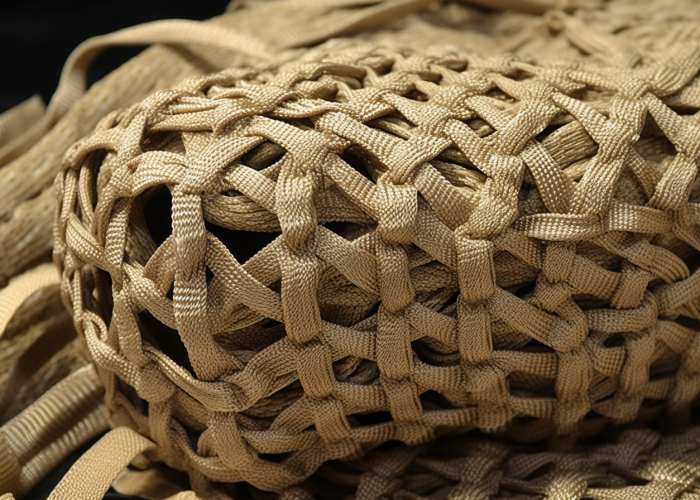As a custom webbing manufacturer, we frequently receive inquiries from engineers and product developers asking whether nylon or polyester webbing offers the right elasticity for their applications. Understanding elasticity differences is crucial for product performance, safety compliance, and cost optimization—which is why we’re sharing our manufacturing insights to help you make informed material decisions and avoid costly design mistakes.
Nylon webbing is significantly more elastic than polyester, stretching 20-30% vs 6-8% under load. Choose nylon for high-stretch applications and polyester for dimensional stability.
This guide covers elasticity differences, environmental effects, and selection criteria to help you choose the optimal webbing for your application.


Webbing manufacturing expert with 15+ years of experience helping product developers build high-performance straps for industrial, medical, and outdoor use.
The fundamental difference lies in molecular structure: nylon features flexible polymer chains with movable segments, while polyester has a rigid aromatic backbone that resists stretching. This structural variance creates dramatically different elasticity characteristics that directly impact product performance and application suitability.
Key Structural Differences:
At the molecular level, nylon’s aliphatic chains contain flexible carbon-carbon bonds that can rotate and extend under stress. These polymer chains move more freely, allowing the material to stretch significantly before reaching failure points. In contrast, polyester’s backbone contains rigid benzene rings that maintain their shape under load, creating natural resistance to deformation.
From our manufacturing experience, we observe how these structural differences affect weaving behavior and final product characteristics. Nylon’s chain flexibility makes it more challenging to achieve consistent tension during production, requiring specialized equipment settings. However, this same flexibility provides superior shock absorption in applications like climbing ropes and vehicle recovery straps, where energy dissipation prevents catastrophic failure.
The crystalline and amorphous regions within each material also influence elasticity. Nylon contains more amorphous (non-crystalline) areas where polymer chains can move freely, contributing to higher stretch capability. Polyester’s higher crystallinity creates a more structured material with predictable dimensional stability—essential for cargo securement and architectural applications where stretch must be minimized.
Design Takeaway: Understanding these molecular differences helps predict performance under load. Specify nylon when energy absorption and flexibility are priorities, and polyester when dimensional accuracy and structural stability are required. Consider how your application’s load characteristics align with each material’s inherent molecular behavior for optimal performance.
Nylon webbing stretches 20-30% under standard loads while polyester webbing stretches only 6-8%, creating a significant performance gap that directly impacts application suitability. This difference becomes even more pronounced at breaking strength, where nylon can reach maximum elongation of 25-30% compared to polyester’s 15-20% stretch before failure.
Performance Comparison at Standard Loads:
Industry-standard tensile testing using protocols similar to ASTM D5034 reveals consistent performance patterns across manufacturers. At 2200 pounds of force—a typical working load for heavy-duty applications—nylon webbing demonstrates its characteristic high elongation while maintaining structural integrity. Polyester webbing under identical conditions shows minimal stretch with excellent load distribution.
The stress-strain relationship differs dramatically between materials. Nylon exhibits a gradual, predictable stretch curve that absorbs energy progressively, making it ideal for dynamic loading situations. Polyester displays a steep initial slope with minimal elongation, indicating superior dimensional stability under static loads but limited shock absorption capability.
From our manufacturing testing, we’ve documented how breaking strength varies with stretch characteristics. High-tenacity nylon maintains 80-90% of its rated strength even at 15-20% elongation, while polyester begins showing strength degradation beyond 5-6% stretch. This performance difference directly influences safety factors and working load calculations.
Design Takeaway: Use these specific stretch ranges as design parameters—nylon for applications requiring 15%+ elongation and polyester when stretch must remain below 10%. Calculate your application’s maximum acceptable elongation before specifying material to ensure performance requirements are met.

Moisture dramatically increases nylon’s elasticity to 84% elongation while polyester remains virtually unaffected, creating a critical design consideration for outdoor, marine, and high-humidity applications. This difference stems from nylon’s hydroscopic nature versus polyester’s water-repellent characteristics.
Moisture Impact Comparison:
Nylon absorbs approximately 8.5% of its weight in water under standard atmospheric conditions, with absorption increasing in high-humidity environments. Water molecules penetrate between polymer chains, acting as a plasticizer that increases chain mobility and reduces intermolecular forces. This molecular-level change fundamentally alters the material’s mechanical properties.
Testing under controlled humidity conditions reveals how moisture absorption affects performance over time. At 65% relative humidity, nylon webbing shows measurable elasticity increases within 24 hours of exposure. Marine environments with 80-90% humidity create even more pronounced effects, with stretch characteristics changing significantly from dry-state specifications.
From our experience with outdoor gear manufacturers, moisture-induced stretch variation creates design challenges for applications requiring consistent dimensional stability. Tent guy-lines made from nylon require frequent re-tensioning in wet conditions, while polyester maintains consistent tension regardless of weather exposure. However, nylon’s increased wet elasticity provides superior shock absorption for climbing applications in adverse conditions.
Polyester’s hydrophobic surface chemistry prevents water absorption, maintaining consistent stretch properties across all moisture conditions. The material’s molecular structure resists water penetration, ensuring that performance specifications remain valid regardless of environmental humidity or direct water exposure.
Design Takeaway: Specify polyester when consistent stretch performance is required across varying moisture conditions, and nylon only when wet-weather elasticity increases won’t compromise product function. Consider environmental exposure during your product’s entire service life when making material selection decisions.
UV exposure reduces nylon’s elasticity by 16-20% after 500 hours while polyester maintains 90%+ of its original stretch properties, making environmental durability a critical factor in outdoor applications. Temperature variations also affect elasticity differently, with nylon showing greater sensitivity to thermal cycling.
Environmental Degradation Rates:
UV radiation breaks down nylon’s polymer chains through photo-oxidation, creating shorter molecular segments with reduced flexibility. This degradation process is cumulative and irreversible, progressively reducing the material’s ability to stretch and recover. In practical terms, nylon webbing exposed to continuous sunlight loses significant elasticity within 6-12 months of outdoor use.
Temperature cycling creates additional stress on elasticity properties. Nylon becomes significantly stiffer at temperatures below -10°C, with elasticity dropping to 10-15% of room temperature values. At elevated temperatures above 60°C, nylon softens and may exhibit permanent deformation under load. These temperature effects compound UV degradation in outdoor environments.
Polyester’s aromatic backbone structure provides inherent UV resistance, maintaining elasticity properties even after extended sun exposure. The material’s thermal stability allows consistent performance across wide temperature ranges without significant elasticity changes. However, extreme heat above 80°C can cause thermal degradation in both materials.
Long-term testing data from our quality assurance programs shows annual performance decline rates. Nylon webbing in outdoor applications typically loses 15-25% of original elasticity per year, while polyester maintains 85-95% of original properties after five years of environmental exposure. These degradation rates directly impact product lifespan and safety margins.
Design Takeaway: Factor UV and thermal degradation into elasticity specifications—reduce nylon’s working elasticity by 20-30% for outdoor applications and maintain full polyester specifications. Consider protective treatments or material substitution when environmental exposure exceeds the material’s degradation tolerance for your application’s required service life.

Manufacturing processes can modify webbing elasticity by 30-40% through weave density control, warp tension adjustment, and post-production treatments, giving designers precise control over final stretch characteristics beyond standard material limitations.
Manufacturing Control Parameters:
Weave density directly influences elasticity by controlling fiber packing. Lower pick counts create space between warp yarns, allowing greater stretch. Higher density weaves restrict fiber mobility, reducing elasticity while increasing dimensional stability. Our production equipment allows precise pick count control within 0.1 picks per inch for consistent specifications.
Warp tension during weaving affects how fibers interact under load. Higher tension pre-stresses fibers, reducing elongation capability in the finished product. Lower tension preserves maximum stretch potential but requires careful balance to avoid weaving defects.
Heat-setting provides dramatic elasticity control through thermal stabilization. Controlled heating under tension allows polymer chains to relax into new configurations, permanently reducing stretch capability. The process involves heating webbing to specific temperatures while maintaining precise tension levels.
Quality control testing throughout production ensures elasticity specifications are met consistently. In-line tensile testing allows real-time adjustments to maintain target stretch values, with measurements documented every 100 meters for batch consistency.
Design Takeaway: Specify elasticity targets during the design phase to leverage manufacturing controls effectively—custom elasticity through production optimization often costs less than switching to exotic materials. Work with manufacturers early to identify optimal parameters for your requirements.
Choose high-stretch webbing (20-30% elongation) for shock absorption applications and low-stretch webbing (6-8% elongation) for dimensional stability, with application requirements and safety standards determining final specifications.
Application-Specific Requirements:
Vehicle recovery straps require 20-30% elasticity to absorb kinetic energy during operations, preventing dangerous recoil effects. Insufficient stretch creates shock loads, while excessive stretch reduces efficiency and safety.
Cargo tie-down applications demand low-stretch webbing to maintain consistent tension. Regulations typically limit stretch to 4-8% maximum to prevent load shifting during transport, ensuring cargo remains properly secured.
Fall protection equipment requires balanced elasticity—typically 6% for positioning lanyards and up to 30% for energy-absorbing lanyards. These specifications balance worker safety with equipment reliability through precise elasticity control.
Compliance requirements vary by industry. OSHA fall protection regulations, DOT cargo securement requirements, and military tactical specifications all include specific elasticity limits. CE marking for European markets may differ from North American standards.
Failure mode analysis guides appropriate selection. High-stretch applications must consider recoil energy and whiplash effects, while low-stretch applications must account for sudden load transfer and shock loading.
Design Takeaway: Match elasticity to your application’s primary function—energy absorption needs high stretch, dimensional control needs low stretch. Analyze failure modes and review applicable safety standards before finalizing specifications to ensure optimal performance and regulatory compliance.

Consider custom elasticity when standard materials don’t meet precise performance requirements or when optimization can significantly improve product function, typically justifying the investment when performance improvements outweigh development costs.
Custom Development Scenarios:
Standard elasticity ranges often leave performance gaps for specialized applications. When requirements fall between available options—needing 12-15% stretch when only 8% and 20% are standard—custom manufacturing becomes optimal. These gaps frequently occur in emerging applications where standard materials weren’t designed for specific demands.
Multi-stage elasticity provides advanced capability where different webbing sections offer varying stretch characteristics. Applications include climbing harnesses with high-stretch comfort zones and low-stretch gear attachment areas, requiring sophisticated manufacturing control.
Performance optimization through custom elasticity often provides competitive advantages. Reducing product weight by 15-20%, improving user comfort through precise tuning, or enhancing safety margins through exact specifications can differentiate products in competitive markets.
The development process includes performance analysis, prototype development, and field testing under actual conditions. Timeline typically requires 8-12 weeks for initial prototypes and 4-6 weeks for production optimization.
Investment analysis considers development complexity and production volumes. Custom solutions become cost-effective when volumes exceed 10,000 linear meters annually or when performance improvements provide significant market advantages.
Design Takeaway: Pursue custom elasticity when standard materials limit product performance or competitive positioning—engage manufacturing partners early to identify optimization opportunities and establish realistic development timelines.

Nylon webbing offers superior elasticity (20-30% stretch) for shock absorption applications, while polyester provides dimensional stability (6-8% stretch) for cargo and structural uses. Material selection depends on performance requirements, environmental conditions, and compliance standards. Contact us to explore manufacturing solutions tailored to your webbing elasticity requirements.
Polyester webbing stretches only 6-8% under load, providing excellent dimensional stability. This low-stretch characteristic makes it preferred for cargo securement, fall protection, and applications requiring consistent tension without significant elongation.
Choose polyester webbing for cargo applications, as regulations typically limit stretch to 4-8% maximum to prevent dangerous load shifting during transport. Polyester’s low stretch and UV resistance ensure consistent performance throughout the cargo’s journey.
Yes, moisture dramatically affects nylon performance, increasing stretch to 84% when wet, while polyester remains unaffected. For consistent outdoor performance regardless of weather conditions, specify polyester webbing for dimensional stability.
Custom elasticity development becomes economically viable at 10,000+ linear meters annually. For smaller quantities, we can often modify standard materials through manufacturing adjustments to meet specific stretch requirements within existing production runs.
Yes, through weave density control, heat-setting, and specialized treatments, we can customize elasticity within ±2-3% of target specifications. Custom development typically requires 8-12 weeks and becomes cost-effective for volumes exceeding 10,000 linear meters annually.
Custom elasticity webbing typically costs 20-40% more than standard materials, with development fees ranging from $5,000-15,000 depending on complexity. This investment becomes cost-effective for production volumes exceeding 10,000 linear meters annually or when performance improvements provide significant competitive advantages.